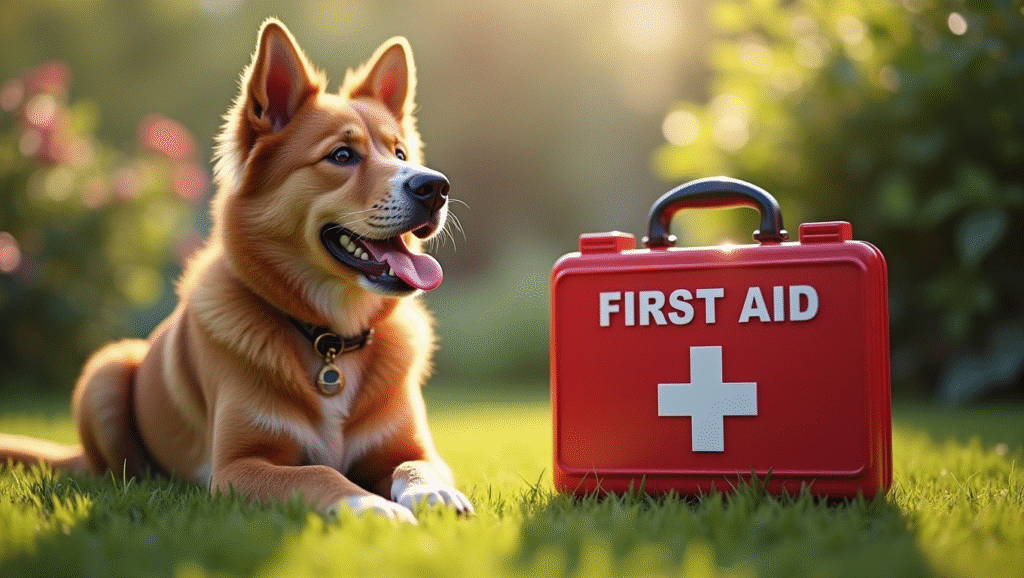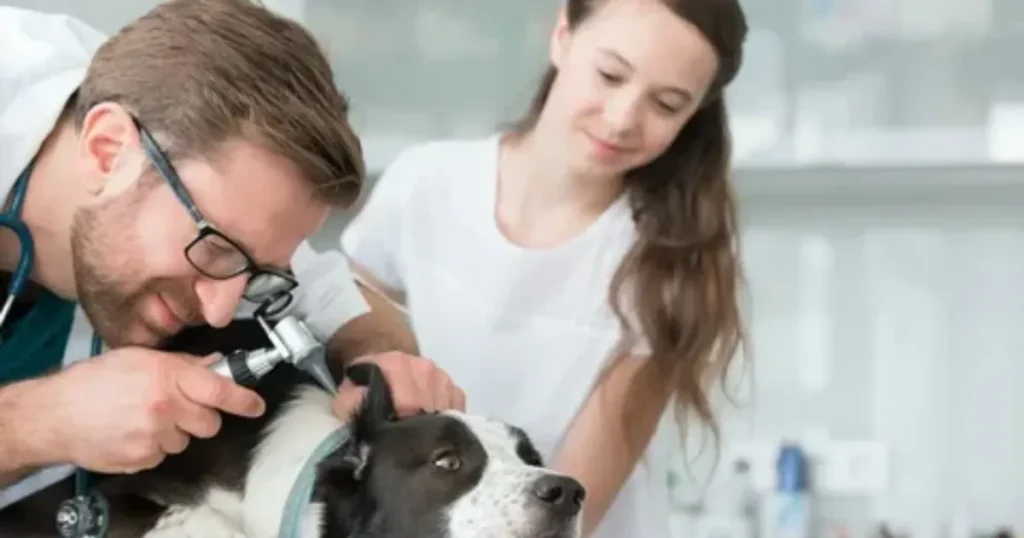Planning for your dog’s safety is crucial, and knowing the 5 Essential Dog First Aid Tips can make a big difference. In this article, you’ll discover the basics of canine emergency care, what supplies you need on hand, and how to handle common health emergencies. We’ll also cover canine CPR, how to respond to injuries, and key veterinary first aid tips every dog owner should know. Let’s get ready to keep your furry friend safe and sound!
Important Points to Remember
- Know how to check your dog’s pulse.
- Always have a pet first-aid kit ready.
- Keep a list of emergency vets handy.
- Learn basic CPR for dogs.
- Stay calm and comfort your dog during emergencies.

Summary
Why You Need to Know These 5 Essential Dog First Aid Tips
Let’s face it, our furry friends can get into trouble sometimes. Whether it’s a minor scrape or something more serious, knowing dog first aid can make a huge difference. Imagine your pup gets into a tussle with another dog or eats something they shouldn’t have. Panic can set in quickly. But if you’re prepared, you can handle the situation calmly and effectively.
Understanding these 5 Essential Dog First Aid Tips isn’t just about being a responsible pet owner—it’s about ensuring your dog gets the best care possible when they need it most. So, let’s dive into why these tips are crucial for every dog parent!
Quick Overview of Canine Emergency Care
What is canine emergency care? It’s all about knowing how to respond when your dog is in distress. Just like you’d want to be prepared for a human emergency, the same goes for our four-legged friends.
First off, it’s important to stay calm. Dogs can sense our anxiety, and if you’re panicking, they might freak out too. Take a deep breath and assess the situation.
Remember that not all emergencies look the same. Some might be obvious—like a bleeding wound—while others can be more subtle, like your dog having trouble breathing. Knowing the signs of distress can help you act quickly.
Lastly, having a basic understanding of canine anatomy and common health issues can really help. For example, knowing where to check for a pulse or how to assess breathing can be vital in an emergency. For more detailed information, consider reviewing preparation strategies for canine emergencies.
Essential Dog First Aid Supplies to Have on Hand
Let’s talk about what you need in your dog first aid kit. Having the right supplies on hand can save time and possibly your dog’s life. Here’s a quick list of essentials you should consider:
- Gauze Pads and Bandages: Crucial for stopping bleeding and protecting wounds.
- Antiseptic Wipes or Solution: To clean wounds and prevent infection.
- Tweezers: Great for removing splinters or ticks.
- Scissors: Handy for cutting bandages or fur away from a wound.
- Thermometer: A dog’s normal temperature is between 101°F and 102.5°F.
- Hydrogen Peroxide: This can induce vomiting if your dog has ingested something toxic (but check with your vet first!).
- Muzzle: Even the sweetest dog can bite when in pain. A muzzle can help keep everyone safe.
- Leash: Always useful for keeping your dog secure, especially in a stressful situation.
- Emergency Contact Numbers: Have your vet’s number and an emergency animal hospital’s number saved in your phone.
You can buy pre-made kits, but it’s also a good idea to customize one based on your dog’s specific needs. Don’t forget to check your supplies regularly to ensure everything is in good condition and not expired!
How to Handle Common Dog Health Emergencies
Emergencies can happen at any time, and knowing how to handle them can mean the difference between a quick recovery and a serious situation. Here’s how to tackle some common dog health emergencies:
1. Bleeding Wounds
If your dog has a bleeding wound, apply pressure with a clean cloth or gauze. Keep the pressure on for several minutes. If the bleeding doesn’t stop, elevate the area above the heart. Always seek veterinary care if the bleeding is severe.
2. Choking
If your dog is choking, act fast. Check their mouth to see if you can spot the object. If you can see it, try to remove it with your fingers. If you can’t, perform the Heimlich maneuver. For small dogs, hold them upside down and give a few firm thrusts to their belly. For larger dogs, place your arms around their waist and thrust inward and slightly upward.
3. Poisoning
If you suspect your dog has ingested something toxic, call your vet immediately. Don’t wait for symptoms to appear. Bring the packaging with you if you know what they ate. If your vet advises it, you may need to induce vomiting using hydrogen peroxide, but only under their guidance. For more on what foods to avoid, check out foods dogs should not eat.
4. Heatstroke
Dogs can overheat quickly, especially in hot weather. Signs include excessive panting, drooling, and lethargy. If you think your dog has heatstroke, move them to a cooler area and offer them water. Wet their fur with cool (not cold) water. If symptoms don’t improve, get them to the vet right away.
5. Seizures
If your dog has a seizure, stay calm. Clear the area around them to prevent injury. Don’t put anything in their mouth; they won’t swallow their tongue. Time the seizure, and if it lasts more than a couple of minutes, call your vet immediately.
A Simple Canine CPR Guide for Pet Owners
Let’s get into something a bit more technical—CPR for dogs. If your dog isn’t breathing or their heart has stopped, you might need to perform CPR. Here’s a simple guide to follow:
Step 1: Check for Breathing
First, check if your dog is breathing. Look for chest movement, listen for breath sounds, and feel for air from their nose. If they’re not breathing, it’s time to act.
Step 2: Call for Help
While you’re getting ready to perform CPR, have someone call your vet or an emergency animal clinic.
Step 3: Perform Chest Compressions
For small dogs, hold them on their side and place your hand over their heart, just behind the elbow. For larger dogs, place your hands on the widest part of their chest. Press down firmly and quickly—about 100 to 120 compressions per minute.
Step 4: Give Rescue Breaths
After every 30 compressions, give two rescue breaths. Close their mouth and cover their nose with your mouth. Blow gently into their nose until you see their chest rise. Then, let the air out and repeat.
Step 5: Continue Until Help Arrives
Keep going with the compressions and breaths until you get help or your dog starts breathing again.
Pet Injury Response: What to Do When Your Dog Gets Hurt
When your dog gets hurt, it’s easy to panic. But staying calm is key. Here’s a simple step-by-step response to follow:
- Assess the Situation: Check how serious the injury is. Is it a minor cut or something more severe?
- Control the Bleeding: If there’s bleeding, apply pressure with a clean cloth or bandage.
- Check for Other Injuries: Look for signs of pain, swelling, or anything unusual.
- Keep Your Dog Calm: Speak softly and pet them gently. This can help reduce their anxiety.
- Transport to the Vet: If the injury is serious, take your dog to the vet. Keep them as still as possible during transport.
Veterinary First Aid Tips Every Dog Owner Should Know
Sometimes, you might find yourself in a situation where you need to provide first aid before getting to the vet. Here are some veterinary first aid tips that can come in handy:
- Know Your Dog’s Normal: Familiarize yourself with your dog’s normal behavior, temperature, and heart rate. This can help you spot something unusual quickly.
- Keep Calm and Assess: Take a moment to assess the situation before jumping into action. Rushing can sometimes make things worse.
- Use a Muzzle When Necessary: If your dog is in pain, they might bite. A muzzle can keep everyone safe. Just make sure it’s not too tight and that they can still breathe.
- Stay Informed: Regularly check for updates on common dog health issues and first aid techniques. The more you know, the better prepared you’ll be.
Preparing for Dog Emergencies: Be Ready, Not Scared
Preparation is key to handling dog emergencies effectively. Here are some practical tips to help you get ready:
- Create a First Aid Kit: As we discussed earlier, have a well-stocked first aid kit specifically for your dog.
- Take a First Aid Course: Consider taking a pet first aid class. Many organizations offer courses that cover everything from CPR to basic injury care.
- Know Your Vet: Make sure you have your vet’s contact information easily accessible. It’s also a good idea to have a backup vet or emergency clinic in mind.
- Practice Calmness: Work on staying calm in stressful situations. You can practice this by simulating emergencies with a friend or family member.
- Stay Updated: Keep up with the latest information on dog health and safety. Join online forums or local pet groups to stay informed.
Conclusion
In conclusion, being prepared for your dog’s emergencies is non-negotiable. The 5 Essential Dog First Aid Tips you’ve learned are your first line of defense when the unexpected happens. Remember, staying calm is crucial; your dog picks up on your energy. Keep that first aid kit stocked and know your vet’s number like the back of your hand.
Whether it’s a minor injury or a serious health scare, your knowledge can make a world of difference. So, take these tips to heart and equip yourself to handle any situation that comes your way. Your furry friend is counting on you!
For more insightful articles on pet care and safety, don’t forget to check out Tech Havela. Happy reading!
Frequently Asked Questions
What are the 5 Essential Dog First Aid Tips?
The 5 Essential Dog First Aid Tips are:
1. Stay calm.
2. Check for breathing.
3. Control bleeding.
4. Treat for shock.
5. Get to the vet.
How do I know if my dog needs first aid?
Look for signs like:
– Trouble breathing.
– Heavy bleeding.
– Unconsciousness.
– Severe pain.
Can I use human first aid supplies on my dog?
Some supplies can help, like:
– Bandages.
– Gauze pads.
But avoid using creams and ointments made for humans.
What should I do if my dog is bleeding?
Apply pressure with a clean cloth.
If it doesn’t stop, wrap a bandage tightly.
Then, get to the vet fast.
How can I treat my dog for shock?
Keep your dog warm and calm.
Lay them on their side.
Don’t give them food or water.
Should I call a vet anytime I need to use first aid?
Yes, always follow up with a vet.
Your dog may need professional care.
Where can I learn more about dog first aid?
Look for:
– Pet first aid classes.
– Online courses.
– Books on dog care.
These resources can help you learn the 5 Essential Dog First Aid Tips!
**Sidnir Vieira**
Founder of TechHavela
A passionate pet and tech content creator, helping dog owners across the U.S. make smarter decisions for their furry friends.



